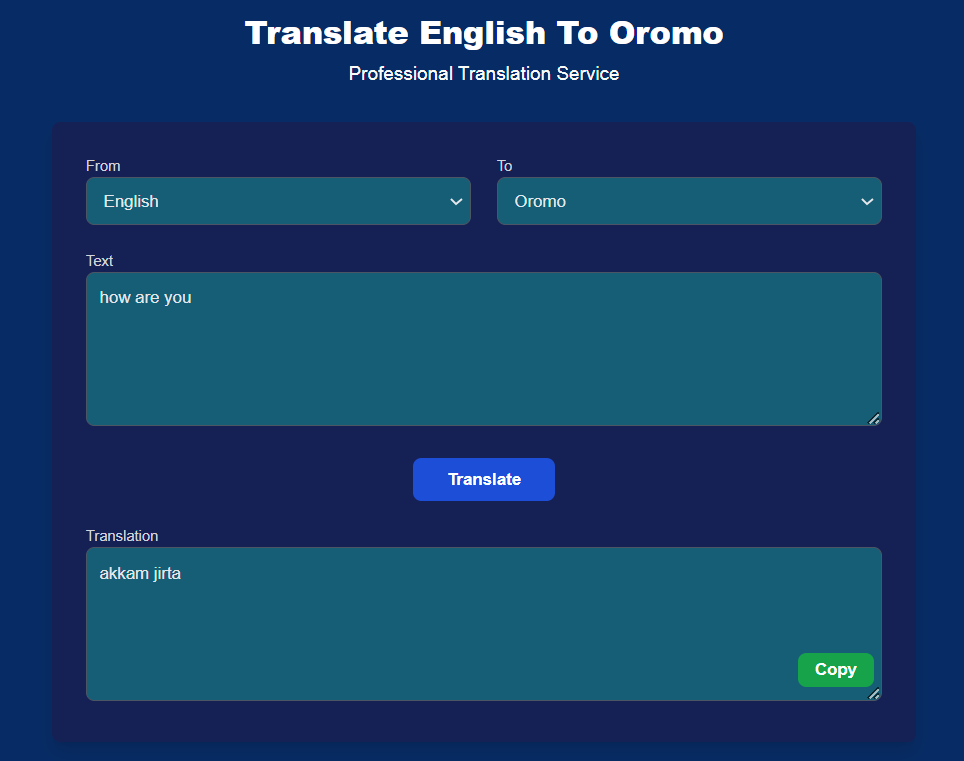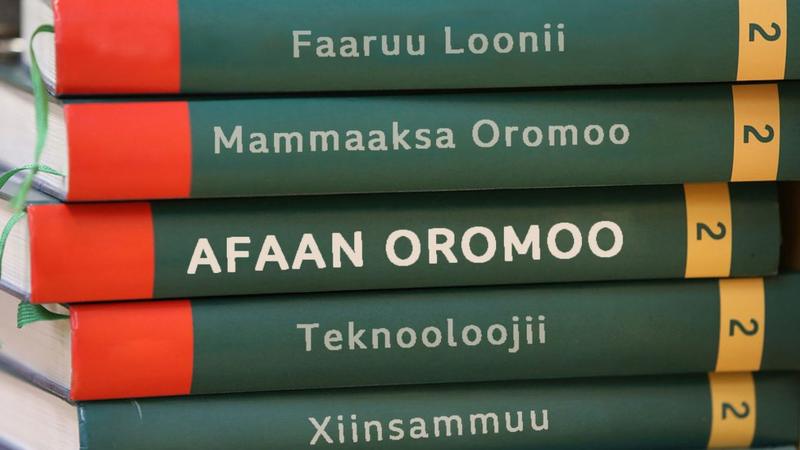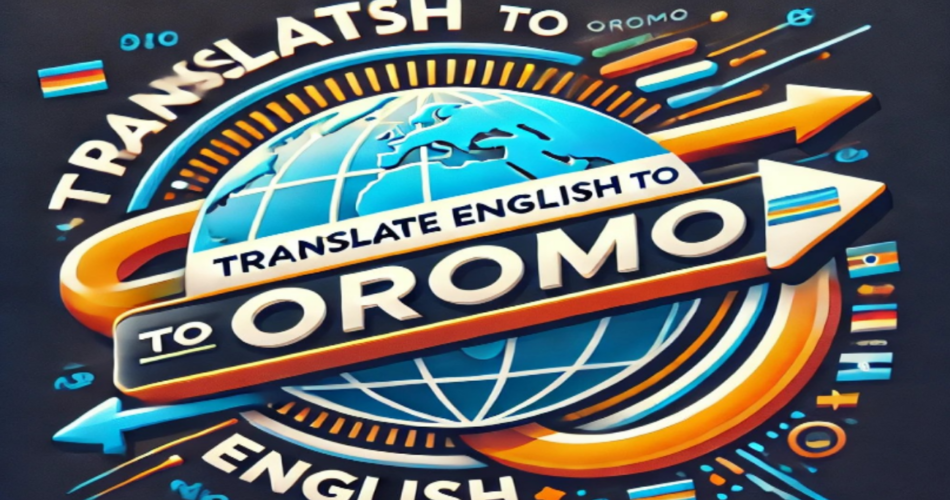Introduction Translate English to Oromo Free
Table of Contents
Translate English to Oromo a concept that has become indispensable in our hyper-connected, ever-shrinking world. As societies interlace and economies intertwine, the art of translation transcends mere words; it becomes a gateway to understanding, collaboration, and growth.
The surge in demand to translate English to Oromo stems from multifaceted needs. For students, it unlocks educational resources. For businesses, it opens doors to a thriving market. For cultural enthusiasts, it breathes life into shared traditions and histories. Every interaction, every exchange, depends on bridging linguistic gaps, and Oromo—a Cushitic language spoken by tens of millions in Ethiopia—stands as a cornerstone in these efforts.
Why is this significant? Because Afaan Oromo is more than a language; it’s a vessel of identity, a repository of heritage. And the need to accurately translate English to Oromo ensures that this vibrant culture remains accessible and celebrated across the globe.
Why Translate English to Oromo?
Translate English to Oromo a task that carries profound implications, reaching far beyond simple word-for-word exchanges. It serves as a bridge between cultures, a conduit for connection, and a key to unlocking opportunities that span continents.
Cultural Significance
Translation isn’t just about communication; it’s about preservation. To translate English to Oromo is to protect and amplify the heritage of the Oromo people, ensuring that their stories, traditions, and knowledge transcend borders. It transforms the local into the global, presenting Afaan Oromo as a living, breathing language that thrives on the world stage while remaining rooted in its origins.
Practical Uses
The need to translate English to Oromo manifests in everyday life in countless ways. From educational materials that empower students to healthcare instructions that save lives, translation is a lifeline. Government services rely on it to engage communities, while businesses depend on it to reach new audiences. Without translation, critical information risks being lost, leaving gaps where understanding should flourish.
Bridging Gaps
At its core, the act of translating English to Oromo is about fostering connection. It’s about breaking down barriers and building bridges—bridges that unite two worlds, two ways of thinking, and two languages. When done well, translation doesn’t just convey meaning; it cultivates empathy, deepens respect, and strengthens bonds between English and Oromo speakers.
In an age where every voice matters, the ability to translate English to Oromo isn’t just a skill; it’s a necessity.
Tools to Translate English to Oromo
In a world powered by technology and innovation, the quest to translate English to Oromo has been met with a plethora of tools and services. From automated platforms to professional expertise, each offers unique advantages and limitations.
Google Translate
When it comes to instant solutions, Google translate english to oromo often takes the spotlight. With its user-friendly interface and accessibility, it provides a quick way to translate English to Oromo at the click of a button. It supports basic phrases, making it an excellent choice for casual users.

However, while Google Translate excels in speed, it falters in depth. Contextual nuances, idiomatic expressions, and culturally embedded meanings are often lost in translation. For those seeking precision, especially in formal or intricate texts, its utility may be limited.
Translate English to Oromo Professional Translation Services
Beyond Google, there’s a growing ecosystem of dedicated tools aimed at facilitating accurate translations. specifically designed to translate English to Oromo often come equipped with features tailored to the language’s unique structure. This platforms may incorporate specialized vocabularies for fields like education, business, or healthcare.

For those requiring unparalleled accuracy, especially in complex documents or culturally sensitive material, human translators are the gold standard. Professional translation services ensure that when you translate English to Oromo, every word resonates with clarity and intent.
Tips to Translate English to Oromo More Effectively
When it comes to translate English to Oromo, success hinges not only on the tools you use but also on how you approach the translation process. Here are some strategies to elevate accuracy and make the process smoother.
Use Simple Language
In the world of translation, simplicity often leads to clarity. To translate English to Oromo more effectively, consider breaking down complex sentences into simpler structures. While advanced tools like Google Translate have come a long way, they still struggle with intricate sentence constructions. Shorter, straightforward sentences are more likely to yield precise, accurate translations.
Simplifying your language doesn’t mean dumbing it down; it means ensuring that every word contributes to clear communication. Avoid convoluted clauses and unnecessary jargon that might confuse both the machine and the human interpreter.
Cross-Check Translations
Relying on a single source of translation—whether automated or human—is risky. The best approach to translate English to Oromo is to cross-check. First, use automated tools to get a rough translation, then follow up with a human review or input. This dual approach minimizes the likelihood of errors and ensures that subtle nuances are captured.
Automated tools are great for quick translations, but they often lack the context needed to produce flawless results. A second set of eyes (or a professional translator) ensures the translation is culturally relevant, contextually accurate, and grammatically sound.
Learn Basic Afaan Oromo
While translation tools are invaluable, nothing beats a foundational understanding of the language. Learning the basics of Afaan Oromo grammar and vocabulary will not only help you translate English to Afaan Oromo more effectively but also allow you to spot potential errors in automated translations.
Knowing the key structures—such as sentence order and common word forms—can help you make more informed decisions when choosing words. A deeper understanding of Oromo culture and idiomatic expressions also equips you to translate with greater precision, conveying meaning rather than just words.
Advancing the Future of English To Oromo Translation

The future of translate English to Oromo is poised for groundbreaking developments, fueled by technological advancements and community-driven efforts. As we look ahead, both innovation and collaboration will play pivotal roles in shaping more accurate and accessible translation tools.
AI and Machine Learning Innovations
Artificial intelligence and machine learning are rapidly transforming the landscape of translation. New AI-driven models are continuously improving in their ability to translate English to Oromo by learning from vast amounts of linguistic data. With each iteration, these systems become more adept at understanding context, picking up on subtle nuances, and delivering translations that are not only grammatically correct but culturally appropriate.
In the near future, AI-powered platforms might not just translate words but also understand the intent behind them. Imagine a world where translate English to Oromo isn’t just a mechanical conversion but an intuitive process that captures tone, idiomatic expressions, and regional variations. These innovations promise to elevate translation accuracy to new heights, breaking barriers in real-time communication, education, and business.
Community Engagement
Technology alone cannot drive the evolution of translation. It’s the contributions of native Oromo speakers, educators, linguists, and community members that will refine and expand these tools. By engaging with those who speak and live the language daily, translation models can become more attuned to the subtleties of Afaan Oromo—whether in rural dialects, contemporary slang, or culturally significant idioms.
The collaborative development of linguistic databases and the sharing of translation resources are essential to build more robust systems. Crowdsourcing efforts, where speakers contribute their expertise, can greatly enhance the quality of translation tools. These contributions will be critical to ensuring that automated systems reflect the full spectrum of the Oromo language and its cultural richness.
Challenges in Translating English to Oromo
Translating English to Oromo presents a variety of challenges. While both languages share common features as part of the Afroasiatic family, they also have significant differences in grammar, sentence structure, cultural context, and available resources. Let’s explore some of the key obstacles faced in this translation process.
Grammar and Sentence Structure: A Barrier to Accuracy
When you translate English to Oromo, one of the first hurdles you’ll encounter is the disparity in grammar and sentence structure. English tends to have a more rigid word order, while Oromo relies heavily on inflections and modifiers. For instance, in English, word order generally follows a subject-verb-object pattern, but in Oromo, the subject often appears at the end of the sentence. This difference can create confusion and distort the intended meaning when translated literally.
Take the English phrase, “I see the man,” which, when directly translated into Oromo, can become “Man the see I.” This example highlights how even simple sentences can become complex due to structural differences.
Cultural Context: Nuances Lost in Translation
Another significant challenge in translating English to Oromo is conveying idiomatic expressions and cultural nuances. English is filled with idioms, slang, and phrases that don’t have direct counterparts in Oromo. For example, the common phrase “It’s raining cats and dogs” has no literal equivalent in Oromo. If translated directly, it might confuse the reader or listener, as they may not understand the metaphor.
Additionally, each language carries its own cultural weight. Words and expressions are shaped by historical, social, and cultural factors. In some cases, translating literally might miss the subtleties of emotion or social significance. Thus, translation must not only be linguistically accurate but also culturally sensitive to avoid misinterpretation or offense.
Limited Resources: The Need for Improved Tools
One of the most pressing challenges in translating English to Oromo is the lack of robust linguistic resources. Compared to other widely spoken languages, there is a scarcity of comprehensive language databases, which limits the efficiency of machine translation tools and dictionaries. As a result, people often rely on personal experience or small-scale resources to perform translations. While this can work in some cases, it leads to inconsistency and a lack of standardization in translations.
The development of better digital tools and databases for the Oromo language would significantly enhance the translation process, making it easier for non-experts to achieve accurate translations. Additionally, it would help bridge the gap in communication between English-speaking and Oromo-speaking communities.
Striving for Effective Translation
Successfully translating English to Oromo requires more than just a word-for-word approach. It requires an understanding of grammatical intricacies, cultural contexts, and the limitations of available resources. By embracing these complexities and seeking improvements in linguistic tools, we can make the translation process more effective, ensuring that the true meaning of the text is conveyed while respecting the linguistic and cultural identity of the Oromo language.




